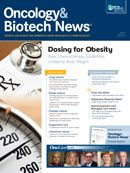Publication
Article
Overcoming Genetic Transformation in Multiple Myeloma
Author(s):
The goal in treating newly diagnosed multiple myeloma is to achieve deep remission and prevent relapse, which is best achieved by targeted combination therapy very early in the course of disease.
Kenneth C. Anderson, MD
The goal in treating newly diagnosed multiple myeloma is to achieve deep remission and prevent relapse, Kenneth C. Anderson, MD, told attendees at the NCCN 7th Annual Congress on Hematologic Malignancies. This is best achieved by targeted combination therapy very early in the course of disease, he added.
“Why am I so passionate about this? Multiple myeloma is a complex disease. The average number of mutations at diagnosis is 58. We have new data showing that at relapse, new mutations arise, copy numbers change, and the translocations change. Although a number of studies have identified genes that are expressed in myeloma, there is presently no universally applicable genetic profile signature that can predict outcome,” said Anderson, director of the Jerome Lipper Multiple Myeloma Center and LeBow Institute for Myeloma Therapeutics at the Dana- Farber Cancer Institute in Boston, Massachusetts.
Various regimens have been studied in newly diagnosed patients using different combinations of drugs, such as bortezomib (Velcade), lenalidomide (Revlimid), dexamethasone, and thalidomide.
“The studies have made a strong case for triplet combination therapy using a proteasome inhibitor and a thalidomide analog [immunomodulatory drug] both pre- and post-transplant. One of our favorite regimens [at Dana-Farber] is lenalidomide, bortezomib, and dexamethasone [RVD],” Anderson said.
A phase II study of RVD showed an overall response rate of 100%, a complete plus partial response rate of 57%, and better than a very good partial response rate of 74% (Blood. 2010;116[5]:679-686).
Another option is combining carfilzomib (Kyprolis), a newly approved proteasome inhibitor, with lenalidomide and dexamethasone (CRD). In a phase I/II study of CRD, 62% of patients achieved at least near-complete response and 42% achieved stringent complete response (Blood. 2012;120[9]:1801-1809).
“Results with CRD are exciting,” Anderson said.
Yet another three-drug regimen involves the oral proteasome inhibitor MLN9708, which is in clinical trials in combination with lenalidomide and dexamethasone. This all-oral regimen achieved 100% response in newly diagnosed patients and may turn out to be a viable option (J Clin Oncol. 2012;30[suppl; abstr 8033]).
“In transplant candidates, a three-drug regimen is most active. Data suggest that we can use new drugs to consolidate and increase response, prolong progression-free survival, reduce the risk of relapse, and extend survival,” Anderson commented.
Several drugs and combination regimens have been studied as consolidation therapy, including bortezomib monotherapy, lenalidomide monotherapy, the combination of the two drugs, and the combination of bortezomib, thalidomide, and dexamethasone.
“The novel drugs used as consolidation and maintenance can prolong progression-free survival and overall survival in some studies. In my paradigm, I want to achieve the best response, consolidate it, and maintain it to preempt chromosomal change,” Anderson said.
At Dana-Farber, lenalidomide is currently being used posttransplant, Anderson said. In the phase III CALGB 100104 study, the median time to progression was 46 months in patients receiving lenalidomide after autologous hematopoietic stem cell transplantation versus 27 months with placebo (N Engl J Med. 2012;366:1770-1778). Anderson said everyone in the trial has now crossed over to lenalidomide maintenance and a survival advantage is still evident for patients randomized to lenalidomide at the start of the trial.
Anderson noted that secondary cancers after lenalidomide are a real concern. In his view, these secondary cancers are more likely to occur in the context of treatment with alkylating agents. This has been shown in several studies, he said.
“The message is to avoid using multiple alkylating agents. Don’t jettison an effective maintenance therapy [because of the risk of secondary cancers],” he said. “The risk of relapse and death from multiple myeloma outweighs the risk of lenalidomide maintenance therapy.”
For nontransplant candidates newly diagnosed with multiple myeloma, the message is the same, Anderson continued. “Incorporate new drugs initially and maintain and improve survival,” he commented.
Anderson concluded with a summary of his discussion: “Don’t allow genetic evolution to occur in this hideously complex disease. Be careful with maintenance and don’t use alkylating agents. A three-drug regimen should be used for induction followed by maintenance therapy.”










